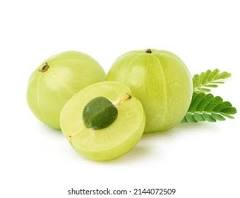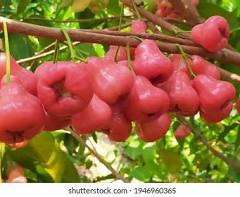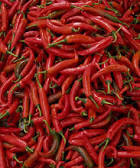Name a Fruit or Veggie A to Z
Replies
-
B - Butter beans
0 -
C- Cranberries
0 -
B - Blueberry jam
1 -
D - daikon (Japanese radish)
1 -
E- English Cucumber 🥒
0 -
F - Fig jam
1 -
G- Grapefruit
Oh how I miss eating grapefruit, it is not compatible with one of my BP medications. 💊
0 -
H - Haricot beans
0 -
I- Indian Gooseberry
Indian gooseberry, also known as amla, is a small, round, greenish-yellow fruit with a sour, astringent taste that is rich in Vitamin C. It is used in traditional Indian medicine, particularly Ayurveda, and in cooking, where it's often pickled or used in chutneys. It's also available as a supplement and is associated with potential benefits like managing cholesterol and heartburn.0 -
J -Jaboticaba
The Jaboticaba tree is native to Brazil, but can also be found in California, Florida, and Hawaii.
The fruit is round or oval-shaped and has thick, purple skin. The fruit’s flesh is white or pink and is eaten fresh or used in jams, jellies, and wines.
1 -
K - Kasha
In English, kasha usually refers to the pseudocereal buckwheat or its culinary preparations. In Slavic languages, "kasha" means porridge. In some varieties of Central and Eastern European cuisine, kasha can apply to any kind of cooked grain. It can be baked but most often is boiled, either in water or milk, but the word can also refer to the grain before preparation, which corresponds to the definition of 'groats'. The word "kasha" is used in Belarus (каша), the Czech Republic (kaše), Lithuania (košė), Poland (kasza), Romania and Moldova (cașa), Russia (каша), Slovakia (kaša), Slovenia (kaša), Kazakhstan, and Ukraine (каша).
1 -
L - Lion's Mane mushroom
Lion’s mane mushrooms have a flavor that many describe as similar to seafood. They can be eaten raw, dried, or cooked. As a supplement, the mushroom comes in powders, liquids, and capsules.
Lion’s mane mushrooms are rich in vitamins such as thiamine, riboflavin, and niacin. They are also a good source of essential minerals such as manganese, zinc, and potassium.
Many health conditions, including heart disease, arthritis, and cancer, involve chronic inflammation and the effects of unstable molecules in our bodies called free radicals. Lion’s mane mushrooms contain potentially potent antioxidants, which are substances that limit the damage of free radicals. They also contain anti-inflammatory substances that show promise in animal studies.
Some studies in animals and small, preliminary studies in people suggest lion's mane mushrooms might have a role in the prevention or treatment of cognitive decline, including Alzheimer's disease.
1 -
Thank you Linda, and the Picture of this type of Mushroom sure looks like a Lions Mane!
M- Mustard Greens0 -
N- Nashi Pears
Nashi pears are a type of Asian pear that are known for their round shape, crisp, apple-like texture, and juicy, sweet flavor. Unlike Western pears, they are eaten firm and have a smooth, thin skin that can be yellow or golden-brown. Originating in East Asia over 3,000 years ago, nashi pears are now a popular and refreshing fruit in many cultures, enjoyed raw or in various dishes.0 -
O - Orange blossoms
Yes, orange blossoms are edible and are used in a wide variety of culinary applications, though they have a strong, floral, and sometimes bitter flavor. They are most commonly infused into water to make orange blossom water, which is used to flavor dishes like desserts, or can be used in teas, cocktails, and as a garnish. Culinary uses
- In desserts: Use to flavor creams, cakes, and fruit salads.
- In drinks: Infuse into water for a floral syrup, or add to cocktails and teas.
- In savory dishes: Incorporate into rice, poultry, or sauces.
- As a garnish: Sprinkle fresh or dried blossoms onto salads or use as a decoration for cakes and drinks.
Considerations
- Flavor: Fresh blossoms have a floral, sometimes soapy, and bitter taste that can be overpowering if not used correctly.
- Preparation: It's often recommended to use them dried or infuse them into water to create a more palatable, aromatic flavor.
- Safety: Orange blossoms are generally considered safe to eat, though individuals with citrus allergies should exercise caution.
- Source: Always ensure the blossoms are from a source intended for consumption, especially if you are picking them yourself.
1 -
I have some orange blossom perfume but I did not realize that they could be eaten. I am a little hesitant to use blossoms for things because they could become a ripe fruit or vegetable later that I really like.
P - Peppermint - I speak from experience that these plants should be in an enclosed area because this plant grows and spreads rapidly. I have some that has grown into our lawn and we mow it down.
0 -
Q - Quararibea cordata (chuppa chuppa)
The tree produces orange-yellow fruits that are soft, juicy, and sweet, each containing 2-5 seeds. These fruits are typically consumed fresh by hand, although they can also be juiced.
Although generally popular, the fruit is variable in quality, as some trees may produce insipid or fibrous fruits. Little work has been done to establish preferred cultivars. Quararibea cordata thrives in wet, deep soils, but it is susceptible to being killed by floods.
1 -
Thank you both for sharing what you have learned, very interesting.
R- Rose Apple
A rose apple is a bell-shaped, crisp tropical fruit native to Malaysia and Indonesia, also known as awax appleorJava apple. It has a waxy, thin skin that can be green, pink, red, or purple, and its flesh is white and watery, with a mild, sweet flavor similar to a pear, sometimes with a hint of rose scent. It is highly hydrating and rich in Vitamin C. CharacteristicsShape:Bell-shaped, sometimes called a "bell fruit".Skin:Thin, waxy, and smooth.Flesh:White, spongy, and watery.Flavor:Mildly sweet, juicy, and refreshing, often compared to a pear or watermelon. The scent is sometimes compared to roses, but it does not taste like an apple.Nutrients:A good source of Vitamin C and hydrating due to its high water content.
0 -
S - Sasafrass
Sassafras (Sassafras albidum) is a North American tree steeped in Indigenous culture throughout its range within deciduous woodlands of the northeast and southeast United States. Indigenous names for the tree include kvfi, pauame, and winauk. Sassafras is not as abundant as other trees in area forests, yet it grows in small numbers in several of Cornell Botanic Gardens’ natural areas.
The origin of the name sassafras is difficult to pinpoint but date to a mispronunciation by 16th century European explorers of the botanical family Saxifrage.
Sassafras has a long history of use among Indigenous people of North America, who have used its leaves, root bark, and wood in a variety of ways. The root bark has long been enjoyed as a flavorful hot or cold tea and also used as a traditional remedy for treating a variety of illnesses, including common head colds and fevers, and as a digestive aid and general restorative tonic for overall health.
Indigenous people have long known that Sassafras leaves are edible. The Choctaw, whose traditional homeland includes Mississippi, Louisiana, parts of Alabama, and the panhandle of Florida, are known for using dried, powdered sassafras leaves to thicken soups and stews. During the 18th century, enslaved West Africans in Louisiana melded their rich food traditions with Native American and European culinary influences, resulting in Louisiana Creole cuisine. Food writer Robert Moss explains in his article, The Real Story of Gumbo, Okra, and Filé, at SeriousEats.com, that gumbo recipes thickened with okra, a traditional West African vegetable, are known as feví gumbo; gumbo thickened with powdered sassafras is known as filé gumbo.
1 -
T- Thai Chilies 🌶️
Thai chillies, also known as bird's eye or prik ki nu, are small, hot peppers native to Southeast Asia and are integral toThai cuisine,adding intense heat and flavor to dishes like curries, sauces, and stir-fries. A popular Thai saying captures their essence: “If it isn't spicy, it isn't tasty,” reflecting how they are not just an ingredient but a cornerstone of authentic flavor.0 -
U -Ugni molinae, commonly known as Chilean guava berry, or strawberry myrtle, is a shrub native to Chile and adjacent regions of southern Argentina.
1 -
V - Vanilla pods
A flavoring derived from the orchid family. The word vanilla comes from the Spanish word vaina, which translates to "little pod".
1 -
W - Wax beans - not as good as a green bean as a producer but they are a pretty contrast in a three bean salad.
1 -
X- Xarel-Lois a white grape variety from Catalonia, Spain, primarily known as one of the three key grapes in Cava sparkling wine. It creates structured wines with high acidity, often displaying citrus, green apple, and herbal notes, and is also used for still wines. A picture of the grape shows small to medium-sized, light-colored berries, and in the glass, still Xarel·lo wine is typically a pale yellow with green hues.0 -
Y - Yali pear
A Yali pear is a traditional Asian pear variety known for its crisp, juicy, and mildly sweet flesh, distinctive elongated or "duck-like" shape, and thin green-to-yellow skin. It is a versatile fruit used for eating fresh, cooking, and making juice or cider, and its trees are a popular addition to gardens and orchards.
1 -
Z- Ziziphus Jujube
The fruit is an edible oval drupe 1.5–3 cm (5⁄8–1+1⁄8 in) deep; when immature it is smooth-green, with the consistency and taste of an apple with lower acidity, maturing brown to purplish-black, and eventually wrinkled, looking like a small date. There is a single hard kernel, similar to an olive pit, containing two seeds. Modern cultivated jujubes have kernels 3.8 times larger than those of wild jujubes.[8]
-
Fruit -
Fruit cross section
1 -
-
A- Avocado 🥑
0 -
B - Black salsify
Black Salsify (Scorzonera hispanica), also called Spanish salsify or black oyster plant, is a cool-season root vegetable prized for its long, smooth, black-brown taproots and tender salad greens. It requires about a 120-day growing season and is more cold-hardy than white salsify.
1 -
C - Celery
1 -
D - Daikon
Daikon (大根; literally "big root") is a generic term for radish in Japanese language. For example, European radish is called hatsukadaikon (廿日大根) in Japan. In the West, the word daikon sometimes refers to long white Asian radish varieties and sometimes Japanese radish varieties. When it is necessary to distinguish the usual Japanese form from others, it is sometimes known as Japanese radish or "true daikon".
0













